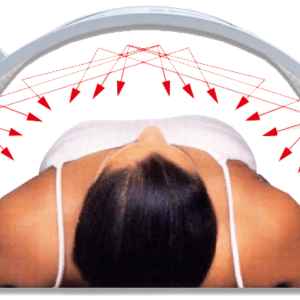Hyperthermia with Chemotherapy
to Treat Inoperable or Metastatic Tumors
Hyperthermia (heat treatment) can increase the effect of chemotherapy treatments. By itself, it can also kill cancer cells. By using heat to treat the whole body, we can treat cancer cells wherever they are throughout the entire body. In this study using heat treatment for cancer, we are testing the combination of hyperthermia - heat treatment and chemotherapy to see:
1) If it improves the effect of the chemotherapy drugs,
2) If it helps the body fight the cancer cells, and,
3) If this treatment is safe and pleasant for the patient.
Hyperthermia (heat) can increase the effect of chemotherapy treatments,
by itself, it can also kill cancer cells.
This study does not offer heat treatment alone. Any patient with inoperable or metastatic neuro endocrine tumors
(any organ), gastric, cholangio carcinoma, small-bowel, lung, head and neck, or melanoma may be treated; however,
the patient will need to undergo some medial tests to make sure this
treatment would be safe for them.
Once you have been accepted for this study, the patient will need to have a Central Venous line (CV line or port) inserted if they do not already have one. (You may have this done by your doctor or we would be happy to help you with this procedure as well.)
The treatment cycle begins with 6 hours of intravenous (IV) hydration followed by an infusion of the anti-caner drug, Cisplatin. In addition, at the beginning of this treatment, you will begin receiving low-dose Interferona injections - once a day - for the entire duration of your participation in this study. The drug, Interferon-a, interrupts the division of cancer cells and slows tumor growth.

Thirty-six hours after the Cisplatin infusion, the patient is treated with fever-range thermal therapy (whole-body heat). When the core body temperature reaches 104°F (40°C), a 30-minute (IV) infusion of another chemotherapy drug, Gemcitabine (gemzar) is given. Cisplatin, low-dose Interferon-a and Gemcitabine are the only chemotherapy drugs used in this treatment plan. No other chemotherapy drugs are allowed to be given under this treatment plan.
The fever-range whole-body heat treatment is performed while the patient is under light conscious sedation. With this type of sedation,you will be awake during the treatment but you will not be uncomfortable. This type of sedation method is used to reduce the discomfort of the 6-hour heat treatment procedure yet allows the patient to respond to verbal commands.
The patients' body temperature is raised to 104°F(40°C) over a period of 60-120 minutes. When thebody first reaches the target 104°F, we administer the Gemcitabine chemotherapy over 60 minutes and continue to maintain the 104°F body temperature for six hours. At the conclusion of the six hours of heat treatment, the patient is cooled off to their normal body temperature, which takes about 30 to 45 minutes. The entire procedure lasts approximately 8 hours. After the treatment is completed, we observe the patient for 2 to 24 hours to make sure the treatment has been well tolerated.
The patient will continue the daily low-doseInterferon-a. Additionally, the patient will be given daily Leukine (sargramostim) cytokine injections usually beginning 3 to 5 days after receiving chemotherapy to help support the immune system by helping the body create more white blood cells,which are important in helping your body fight infection.
After treatment, the patient will need a complete blood count with platelet and differential count each week. These lab studies can be done at the patient's own doctor's office or hospital as long as you make sure that the results are faxed to us.They can also be done in our clinic. We will see a patient again approximately three to four weeks and the treatment cycle will be repeated.
We always attempt to perform at least two thermo-chemotherapy cycles. After the second treatment, CT and/or MRI scans are repeated to see if the tumor has changed. These scans,along with a physical examination and the lab studies, are used to determine if additional heat treatments will be performed. Additional treatments continue based on how well a patient responds to the treatment. There is no limit to the number of heat treatments a patient may have.
National Cancer Institute